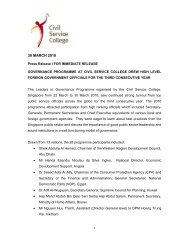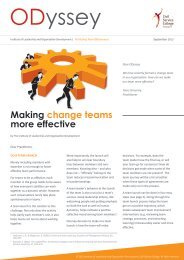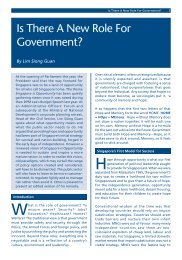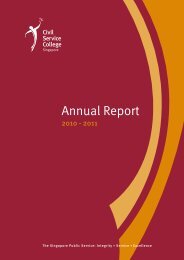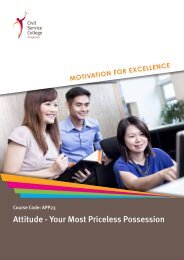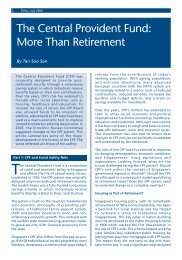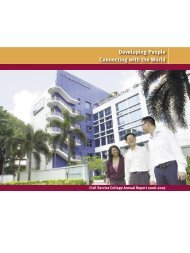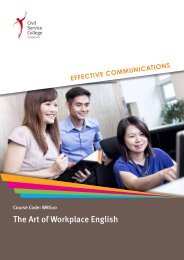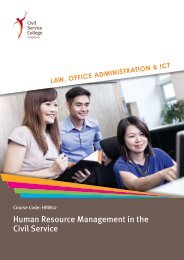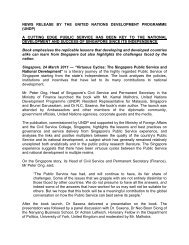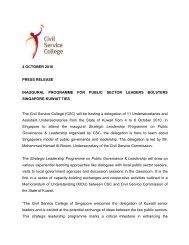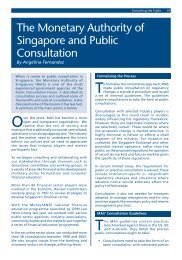Public Consultation Toolkit - Civil Service College
Public Consultation Toolkit - Civil Service College
Public Consultation Toolkit - Civil Service College
Create successful ePaper yourself
Turn your PDF publications into a flip-book with our unique Google optimized e-Paper software.
<strong>Public</strong> <strong>Consultation</strong> <strong>Toolkit</strong> 53 54 <strong>Public</strong> <strong>Consultation</strong> <strong>Toolkit</strong><br />
Decision audit analysis<br />
Key considerations<br />
1. Were the strategic objectives of the consultation exercise met?<br />
2. Did the consultation result in an informed decision, shape a policy or an action?<br />
3. Has the consultation helped to improve the effectiveness of a service by making it match users’<br />
needs more closely?<br />
4. Did it lead to a change of policy or service?<br />
5. Has the consultation improved the relationship with the stakeholders?<br />
Process review<br />
Assessment<br />
Yes No NA<br />
1. 7.2. Was there Step sufficient 9: Assess awareness effectiveness generated about the consultation of the public exercise for consultation the targeted exercise<br />
stakeholders?<br />
2. Did all parties (e.g., staff, participants and partners) understand the objectives?<br />
3. Was the timeframe and process adhered to?<br />
4. Were the level of resources and support right?<br />
5. Were the right stakeholders involved?<br />
6. Was the consultation accessible (e.g., were materials available in other languages and formats,<br />
where necessary? Were interpreters provided or necessary? Were venues accessible?)<br />
The effectiveness of the public consultation exercise should be evaluated to:<br />
7.<br />
•<br />
Were<br />
Assess<br />
the<br />
whether<br />
methods used<br />
involving<br />
appropriate<br />
the stakeholders<br />
for the objectives?<br />
contributed to improved services, actions or<br />
8. Were decision the numbers making; that took part expected – was the initial target reached?<br />
9. • Did Find officers out what get the worked, information what needed did not in sufficient and why; time, depth and quality?<br />
10. • Were Increase results learning made known and to improve participants, future the wider practice; public and and relevant partner organisations?<br />
• Identify areas of improvement for future exercises.<br />
Participant satisfaction<br />
1. Did participants understand why they were asked to be involved in this consultation?<br />
There are three suggestions for assessing effectiveness:<br />
2. Did participants know their scope of influence (i.e., what this consultation could and could not<br />
influence)?<br />
1. Decision analysis, which assesses whether the strategic objectives of the consultation<br />
3. Was exercise the information were met; easy to understand, and did it provide them with sufficient background to<br />
provide meaningful feedback?<br />
4. 2. Was Process it easy review, for participants which to assesses give their views? the effectiveness of the consultation process, e.g., whether<br />
5. Were the timeline participants was given adhered the opportunity to, response to say everything rate was met; they wanted and to say?<br />
6. Were the practical arrangements for this consultation (e.g., meeting venues, refreshments,<br />
3. interpreters, Participant facilitators) satisfaction, satisfactory which to the evaluates participants? the general sentiment/satisfaction of participants<br />
7. Did who participants took part feel in that the their consultation contribution process. was listened to and respected?<br />
8. Are participants satisfied with the reported findings of the consultation exercise?<br />
The checklist on the following page (see Table 7 2) can be used to assist officers in assessing the<br />
9. Are participants aware of the outcome and key considerations behind the agency’s decision or<br />
course effectiveness of action? of consultation exercises.<br />
10. Do participants think the consultation made a difference to the decision?<br />
11. Did it generate a considerable volume of feedback?<br />
Assessment: Number of “Yes”<br />
Decision audit analysis = /5<br />
Process review = /10<br />
Participant satisfaction = /11<br />
Total = /26<br />
8. Conclusion<br />
This <strong>Toolkit</strong> serves to provide public officers with an overview of the process and tools for public<br />
consultation exercises. Given the diversity of stakeholders and issues/policies faced by different<br />
agencies at differing levels, the <strong>Toolkit</strong> is not meant to be prescriptive. Rather, agencies are<br />
encouraged to customise or modify the content to suit their own context and requirements.<br />
The <strong>Toolkit</strong> is an evolving document. New challenges may be encountered or new avenues/<br />
ideas generated. Agencies are encouraged to document their experiences in each consultation<br />
exercise for future reference and further improvements to the public consultation process.<br />
Table 7-2: Checklist for assessment of effectiveness



